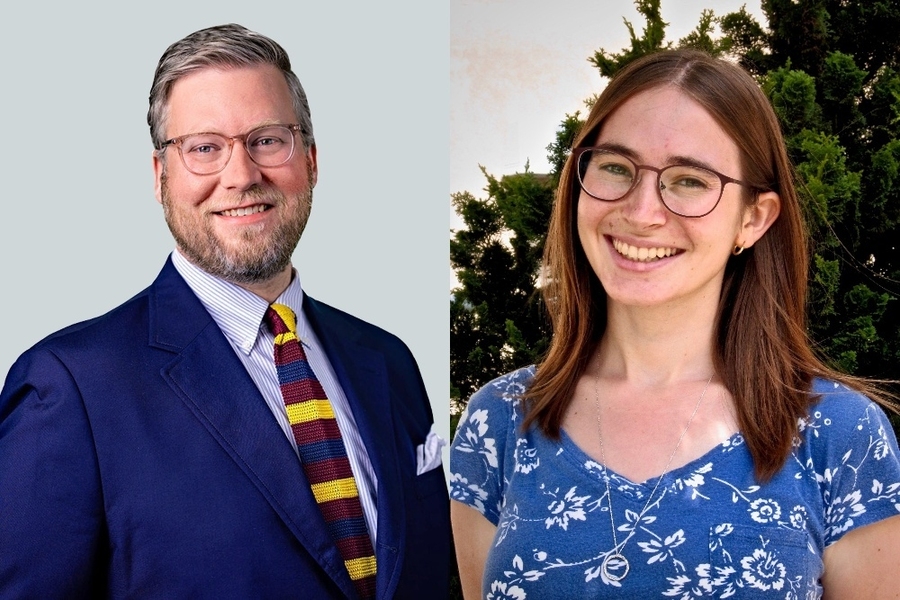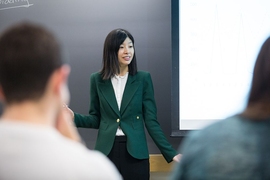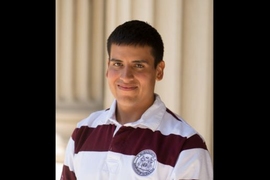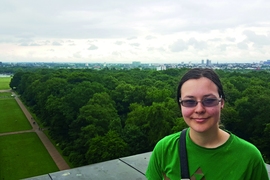Students who engage in energy studies at MIT develop an integrative understanding of energy as well as skills required of tomorrow’s energy professionals, leaders, and innovators in research, industry, policy, management, and governance. Two energy alumni recently shared their experiences as part of MIT’s energy community, and how their work connects to energy today.
Abigail Ostriker ’16, who majored in applied mathematics, is now pursuing a PhD in economics at MIT, where she is conducting research into whether subsidized flood insurance causes overdevelopment. Prior to her graduate studies, she conducted two years of research into health economics with Amy Finkelstein, the John and Jennie S. MacDonald Professor of Economics at MIT. Addison Stark SM ’10, PhD ’15, whose degrees are in mechanical engineering and technology and policy, is the associate director for energy innovation at the Bipartisan Policy Center in Washington, which focuses on implementing effective policy on important topics for American citizens. He also serves as an adjunct professor at Georgetown University, where he teaches a course on clean energy innovation. Prior to these roles, he was a fellow and acting program director at the U.S. Department of Energy’s Advanced Research Projects Agency-Energy.
Q: What experiences did you have that inspired you to pursue energy studies?
Stark: I grew up on a farm in rural Iowa, surrounded by a growing biofuels industry and bearing witness to the potential impacts of climate change on agriculture. I then went to the University of Iowa as an undergrad. While there, I was lucky enough to serve as one of the student representatives on a committee that put together a large decarbonization plan for the university. I recognized at the time that the university not only needed to put together a policy, but also to think about what technologies they had to procure to implement their goals. That experience increased my awareness of the big challenges surrounding climate change. I was fortunate to have attended the University of Iowa because a large percentage of the students had an environmental outlook, and many faculty members were involved with the Intergovernmental Panel on Climate Change (IPCC) and engaged with climate and sustainability issues at a time when many other science and engineering schools hadn’t to the same degree.
Q: How did your time at MIT inform your eventual work in the energy space?
Ostriker: I took my first economics class in my freshman fall, but I didn’t really understand what economics could do until I took Energy Economics and Policy [14.44J/15.037] with Professor Christopher Knittel at the Sloan School the following year. That class turned the field from a collection of unrealistic maximizing equations into a framework that could make sense of real people’s decisions and predict how incentives affect outcomes. That experience led me to take a class on econometrics. The combination made me feel like economics was a powerful set of tools for understanding the world — and maybe tweaking it to get a slightly better outcome.
Stark: Completing my master’s in the Technology and Policy Program (TPP) and in mechanical engineering at MIT was invaluable. The focus on systems thinking that was being employed in TPP and at the MIT Energy Initiative (MITEI) has been very important in shaping my thinking around the biggest challenges in climate and energy.
While pursuing my master’s degree, I worked with Daniel Cohn, a research scientist at MITEI, and Ahmed Ghoniem, a professor of mechanical engineering, who later became my PhD advisor. We looked at a lot of big questions about how to integrate advanced biofuels into today’s transportation and distribution infrastructures: Can you ship it in a pipeline? Can you transport it? Are people able to put it into infrastructure that we’ve already spent billions of dollars building out? One of the critical lessons that I learned while at MITEI — and it’s led to a lot of my thinking today — is that in order for us to have an effective energy transition, there need to be ways that we can utilize current infrastructure.
Being involved with and becoming a co-president of the MIT Energy Club in 2010 truly helped to shape my experience at MIT. When I came to MIT, one of the first things that I did was attend the MIT Energy Conference. In the early days of the club and of MITEI — in ’07 — there was a certain “energy” around energy at MIT that really got a lot of us thinking about careers in the field.
Q: How does your current research connect to energy, and in what ways do the fields of economics and energy connect?
Ostriker: Along with my classmate Anna Russo, I am currently studying whether subsidized flood insurance causes over-development. In the U.S., many flood maps are out of date and backward-looking: Flood risk is rising due to climate change, so in many locations, insurance premiums now cost less than expected damages. This creates an implicit subsidy for risky areas that distorts price signals and may cause a high number of homes to be built. We want to estimate the size of the subsidies and the effect they have on development. It’s a challenging question because it’s hard to find a way to compare areas that seem exactly the same except for their insurance premiums. We are hoping to get there by looking at boundaries in the flood insurance maps — areas where true flood risk is the same but premiums are different. We hope that by improving our understanding of how insurance prices affect land use, we can help governments to create more efficient policies for climate resilience.
Many economists are studying issues related to both energy and the environment. One definition of economics is the study of trade-offs — how to best allocate scarce resources. In energy, there are questions such as: How should we design electricity markets so that they automatically meet demand with the lowest-cost mix of generation? As the generation mix moves from almost all fossil fuels to a higher penetration of renewables, will that market design still work, or will it need to be adapted so that renewable energy companies still find it attractive to participate?
In addition to theoretical questions about how markets work, economists also study the way real people or companies respond to policies. For example, if retail electricity prices started to change by the hour or by the minute, how would people’s energy use respond to that? To answer this question convincingly, you need to find a situation in which everything is almost identical between two groups, except that one group faces different prices. You can’t always do a randomized experiment, so you must find something almost like an experiment in the real world. This kind of toolkit is also used a lot in environmental economics. For instance, we might study the effect of pollution on students’ test scores. In that setting, economists’ tools of causal inference make it possible to move beyond an observed correlation to a statement that pollution had a causal effect.
Q: How do you think we can make the shift toward a clean energy-based economy a more pressing issue for people across the political spectrum?
Stark: If we are serious about addressing climate change as a country, we need to recognize that any policy has to be bipartisan; it will need to hit 60 votes in the Senate. Very quickly — within the next few years — we need to develop a set of robust bipartisan policies that can move us toward decarbonization by mid-century. If the IPCC recommendations are to be followed, our ultimate goal is to hit net-zero carbon emissions by 2050. What that means to me is that we need to frame up all of the benefits of a large clean energy program to address climate change. When we address climate change, one of the valuable things that’s going to happen is major investment in technology deployment and development, which involves creating jobs — which is a bipartisan issue.
As we are looking to build out a decarbonized future, one thing that needs to happen is reinvesting in our national infrastructure, which is an issue that is recognized in a bipartisan sense. It’s going to require more nuance than just the pure Green New Deal approach. In order to get Republicans on board, we need to realize that investment can’t be based only on renewables. There are a lot of people whose economies depend on the continued and smart use of fossil resources. We have to think about how we develop and deploy carbon capture technologies, as these technologies are going to be integral in garnering more support from rural and conservative communities for the energy transition.
The Republican Party is embracing the role of nuclear energy more than some Democrats are. The key thing is that today, nuclear is far and away the most prevalent source of zero-carbon electricity that we have. So, expanding nuclear power is a critically important piece of decarbonizing energy, and Republicans have identified that as a place where they would like to invest along with carbon capture, utilization, and storage — another technology with less enthusiasm on the environmental left. Finding ways to bridge party lines on these critical technologies is one of the biggest pieces that I think will be important in bringing about a low-carbon future.









